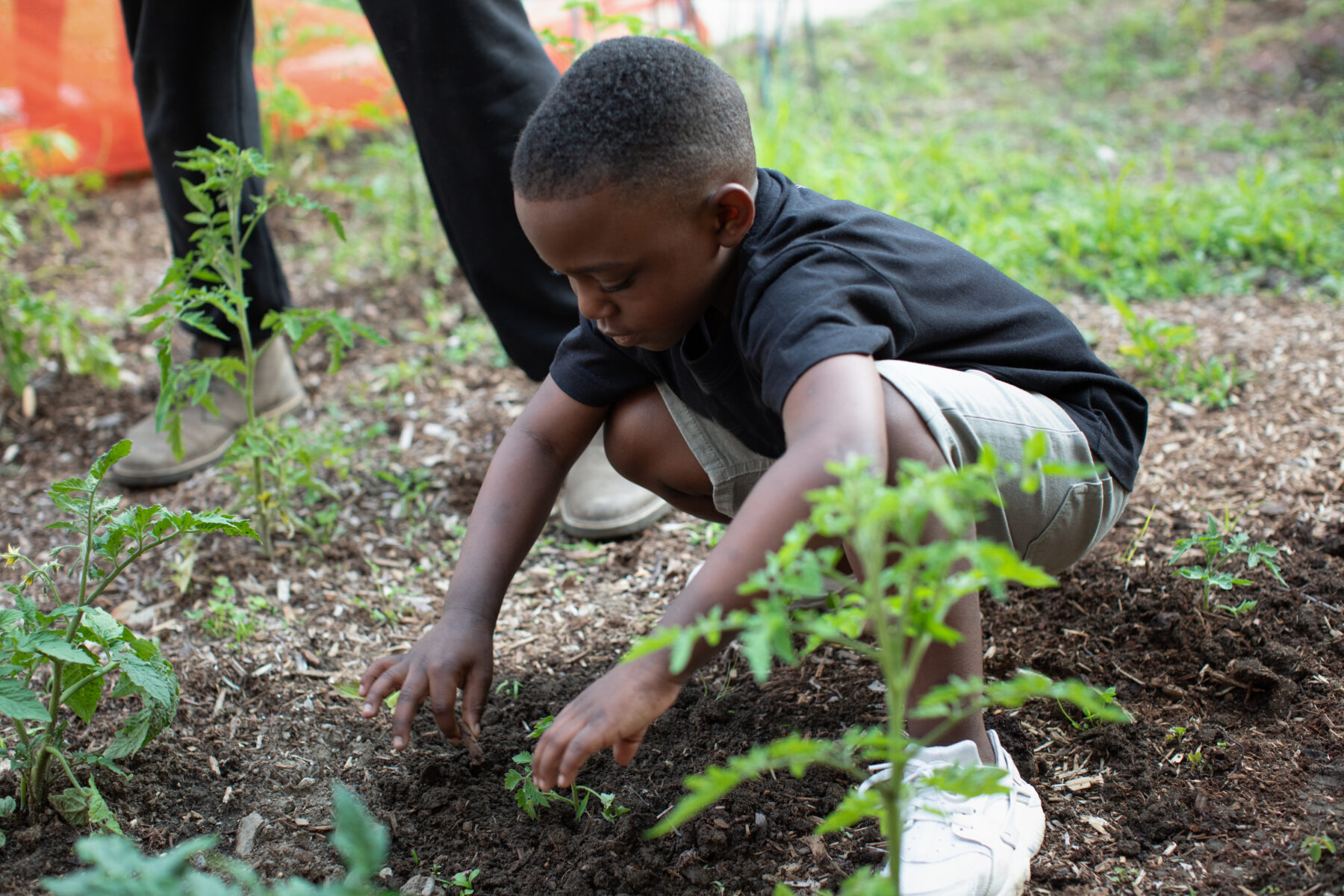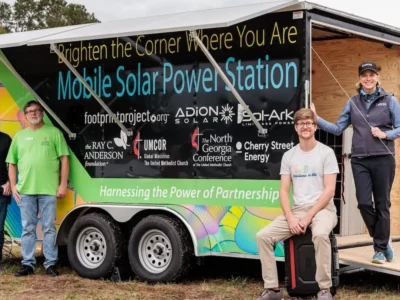From the Garden of Eden in Genesis to the new Jerusalem in Revelation, all of history stands on the resurrection of Jesus Christ. This is the foundation on which the St. Ambrose Episcopal Church of Raleigh, North Carolina builds its passion for creation care, according to The Reverend Jemonde Taylor.
The people at St. Ambrose “take Mark’s account of resurrection literally,” Father Taylor explained. “Go into all the world—the Greek word is ‘cosmos’—and proclaim the resurrection of Jesus Christ, who brings new life for humanity and the entire universe.”
Father Taylor has been Reverend for St. Ambrose for over a decade now and has overseen multiple projects to improve the natural environment around the church and its community. But the roots of that calling are far deeper than environmentalism for the fun of it. Creation care is about resurrection and survival.
When the resurrection of Jesus Christ is extended to the ends of the earth and beyond, far more than the souls of humanity are changed. “What does it look like to have a resurrected environment, school system, penal system, and other manifestations of resurrection?” asked Father Taylor.
A History of Environmental Injustice and Racism
This question is as old as the St. Ambrose congregation itself.
St. Ambrose was founded in 1868, at the same time and by the same person who founded Saint Augustine’s University, which was founded by Episcopalian clergy for the education of previously enslaved people. The church was first established in a region known as Smoky Hollow, where freed Black people lived during slavery. Smoky Hollow got its name from the constant presence of noxious gas that settled in low lying areas surrounding Raleigh, areas where white people didn’t want to live.
“Our founding as a church is in response to environmental injustice,” Father Taylor shared. “With low lying air and all of that train smoke, it’s reasonable to assume there were respiratory disease and illness in that population more so than compared to other populations. Our genesis was in a place of environmental racism.”
When two color lines were established to delineate neighborhoods where black and white people could live and work in Raleigh 30 years later, St. Ambrose found itself “on the wrong side of both color lines,” said Father Taylor. “Neighborhoods had changed [since our inception] and a large corporation eyed our property for a cotton mill.”
To keep serving their community, the color lines forced the St. Ambrose congregation to move. In June of 1900, “We jacked up our church onto log rollers and physically rolled it a mile and a half south to the Black part of town, near Shaw University,” said Father Taylor. The church remained in that location for 65 years, until the congregation moved to their current location in Rochester Heights. City council established two segregated neighborhoods and Rochester Heights was one of them, located in the Walnut Creek wetlands.
“This is where raw sewage had been dumped for 70 years. Then it became a de facto dumping site for garbage,” and now, it’s where the city ‘dumped’ its Black population, Father Taylor said. “Wetland that has been through that much devastation doesn’t act like a wetland should, it backs up like a tub and floods.” Homes were washed off their foundation, even though residents had been promised by city council that their homes would not flood.
Forty more years passed until one day, Lillian Currin, a member of the St. Ambrose’s congregation, came to the rector, Arthur Calloway, and said, “I’m tired of my basement and home flooding.” She urged the church to do something to help the families in their community. Another congregant, Norman Camp, helped to establish Episcopalians for Environmental Justice, which later became Partners for Environmental Justice.
The group got to work cleaning up the wetlands. They pulled out thousands of tires, cars, other trash, and even an autoclave, which was likely dumped by the university.
Shortly thereafter, Norman Camp was elected to the city parks and recreation board, working together with St. Ambrose and the City of Raleigh to zone five acres of protected space. In 2009, the church worked to get a $2 million educational center built on Walnut Creek, which was named after Norman and Betty Camp. In 2014, a $1 million bond was added to an existing bond issue to expand the 5-acre nature center into a 50-acre park at Walnut Creek.
“We did it out of necessity and out of survival,” Father Taylor said. “The work we do is not just a theological exercise. If we do not do something we will be washed away because of flooding.”
St. Ambrose Flood Mitigation Efforts
The community’s flood problems arose from non-environmental stressors. St. Ambrose is the lowest point in a 40-square-mile watershed, so all of the development and paving, cutting down of trees, and storm water comes running down Walnut Creek, past St. Ambrose.
“I’ve been here a decade,” said Father Taylor. “I can tell the water is creeping closer and closer.”
The church took on one of the largest developer in North Carolina, which was building a 150-acre development half a mile upstream from St. Ambrose. The initial rezoning effort stated that there would be “no expected stormwater impact from this development.” That brief statement became a 1,500 word document that required greenwater infrastructure, low-impact development, and a legally binding agreement to provide a $2.5 million grant to mitigate flooding downstream.
St. Ambrose is launching a podcast, available in early June, called Wading Deep. As part of a three-phase grant, it will share the history of environmental racism in Raleigh and then speak on an ongoing basis about the underserved and marginalized communities that have been subjected to environmental racism.
St. Ambrose Creation Care Efforts
St. Ambrose wanted to be an example for other congregations to pursue green initiatives for their campus. From 2017 to 2018, as part of a capital campaign, the church invested in a number of upgrades to reduce their ecological footprint. This included the installation of Low-E glass to decrease energy consumption, HVAC system upgrades, LED lights, a revamped water system to use 80% less water, and more.
The church also installed a rain garden, which is part of the St. Ambrose Prayer Garden. The garden has two 100-square-feet bioretention rain gardens, which collect rainwater from the roof, driveway, or street, preventing polluted rainwater from running into Walnut Creek. The prayer garden has two 850-gallon cisterns that collect rain water from the roof to use as a drip-line irrigation system. The two cisterns and rain gardens together divert thousands of gallons of polluted stormwater from entering the creek.
A Vision for Healing
The church’s most recent effort is the realization of a vision that Father Taylor had when he first arrived at St. Ambrose ten years ago.
As he walked the grounds of the church, “I began to see four dispensations at St. Ambrose: a pre-European engagement with the wetlands (certainly indigenous people had a different engagement with creation), space where the wetlands were pristine. Then there was the second dispensation, the European engagement, which led to the devastation of the wetlands with the dumping of garbage and so on. The third dispensation was the zoning of that space where black people could live. Even though the black community had no hand in denigrating the wetlands, they became the people who bring healing and wholeness back to it. And finally the fourth dispensation, where the wetlands would bring about healing to the black community.”
The realization of the fourth dispensation is underway. In addition to funding the Wading Deep podcast initiative, the Episcopal Church’s Task Force on Care of Creation and Environmental Racism provided grant money toward an ADA-accessible and environmentally conscious labyrinth and a therapeutic healing garden in the St. Ambrose prayer garden. Father Taylor envisions the garden as a place to tend to the spiritual, physical, emotional, and mental health of the community.
The garden will be a location for therapeutic gardening, with trained therapists onsite to work alongside people from the community for emotional healing. It will also tend to the physical needs of its community members by opening opportunities to enter nature, to walk and exercise in the garden space.
Efforts to complete the healing garden are underway now. “It will be so busy we’ll have to find other green space, we’ll have to go across Walnut Creek wetland center to have some sessions there,” said Father Taylor.
“I want to see it grow and flourish. It is so needed coming out of this pandemic. With high rates of depression and our young people dying by suicide, it’s perfect timing to be starting this effort,” Father Taylor said. “We’re just seeing the first wave of emotional impact of COVID and that need is going to continue to grow.”
The Lord taught his people to pray, “Thy kingdom come.”
“We’re trying to give glimpses of God’s kingdom now of that descending kingdom,” Father Taylor said.





 Copyright
2024
Root and Vine
Copyright
2024
Root and Vine